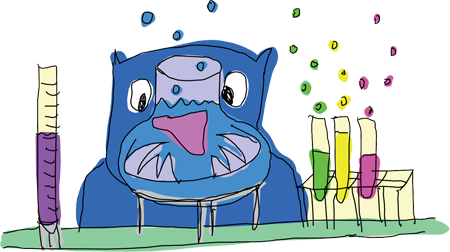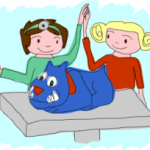
“One Health”
It is clear we can no longer consider animal health and welfare in isolation of human health and welfare. “Aggression” in dogs is one of the main reasons that pet dogs are given up to shelters or indeed euthanased. Bites in young children in their own home result in a significant number of injuries each year that require medical treatment. So dog bites are an issue that spans both human and animal welfare and it is essential veterinarians have a role, not only in investigating the causes, but communicating current ideas to the public.
Opportunity to work closer with human health care professionals
Some health care professionals see the problem only from the child injury perspective, and so may call for a ban on the keeping of dogs. However, there is much scientific evidence showing the positive benefits to human health and child development of having a dog in the family. The challenge is therefore to devise safe ways of living with dogs such that families can enjoy all the benefits but reduce the risks of harm. Fortunately this is possible, but the first step is admitting the risks exist.
The Blue Dog was developed by a team of professionals from multi-disciplines, including veterinarians, behaviourists, dog trainers, paediatricians, child psychologists, school teachers, artists and communication scientists. To be most effective at a local level it would be preferable to develop a liaison group of interested people from these disciplines. At the very least, veterinarians should strive to have closer links with local health care professionals.
Educating the public about the reality of bites
If one accepts the arguments about “one health”, then clearly veterinarians have an important role in public education. It is essential that the message is scientifically correct and that all the various interested professional groups are giving the same message. It is also essential that the prevention message is given in a style that is most likely to alter the behaviour of the target group in the appropriate way.
Opportunity to work closer with local schools / community
Education can be targeted at any age group, but is probably most effective with children. Remember though, teachers are the professionals in the classroom, and it is important that they guide the lesson in whatever way they think to be best.
Helping to enhance the caring image of the practice
The points discussed above illustrate moral reasons why veterinarians should promote the Blue Dog in their clinics and the community. However, promoting a caring image is also “marketing” and so has a financial spin-off.

The black and white photo shows the author in a local school in the 1980’s. Many of the children shown are now parents with children at the same school – and some are clients at out clinic, maybe as a result of the school programmes all those years ago! The Blue Dog offers a more structured way of being involved in schools and the community.
Client’s perception as to whether they have a problem
The Blue Dog message is scientifically correct and well accepted by international veterinary behaviourists. All dogs have the potential to bite, and whether they do or not depends on the overall context of the situation. There are many myths associated with bites – the consideration of “dangerous breeds” suggests there are “safe breeds”. Neutering is often (wrongly) thought to prevent dogs from biting humans. Status dogs are certainly a problem in our society, but checking out the headline facts and figures shows that most bites occur in young children in the home by the family dog. It is easy to understand though why many clients do not appreciate that their family may be at risk.
Fear Messages
At the other extreme, a client may believe there is a real risk, but feel unable to effectively protect the family. This may provoke a “fear” response as a means of coping with the situation – and the prevention message may be rejected as a result.
A balanced approach
So there are inherent difficulties about communicating a prevention message (similarly with worming!) and it is important to adopt a balanced approach. For this very reason, the Blue Dog website has been designed to give information about all the good things about having a dog in the family as well as exposing people to the prevention message.
There are many opportunities for you to benefit from using the Blue Dog programme within the practice.
In common with introducing any new initiative within a clinic, it is important that all members of staff (veterinarians, nurses and receptionists) are familiar with the concepts and so are totally “on-board”. A presentation to the staff might be of value, and a power-point presentation is available in the downloads section.
New Puppy consultations
This is a time that clients will generally want to soak up a mass of information, so providing written sheets within puppy packs is often useful (see downloads section for brochure ideas). They will also find it difficult to accept that this jolly bundle of fluff would ever bite their child – so do not alienate them. Just mention the potential problem, maybe by suggesting they can sometimes react in an unexpected way if the circumstances are right.
The Blue Dog website is a good source of information with videos on puppy behaviour as well as a wealth of other information and this may be a positive way to introduce the Blue Dog at this time.
Puppy parties
Many of the points made above are also valid for puppy parties. You might consider giving a copy of the CD/Parent guide free of charge to puppy party participants (or incorporate the cost into the fee for the puppy parties).
Client evenings
The practice may arrange occasional evenings for clients when a short presentation is given as part of a social evening. The Blue Dog is an interesting topic that makes a change from fleas or worms!
Check out the download section for a power-point presentation you can adapt. There are also graphics you can download to help design posters for the event.
Open days
These should be fun events giving you an opportunity to show off your clinic to clients (and potential clients). Catering for children is an important aspect of a successful day. The interactive Blue Dog CD-ROM may prove popular with children while introducing the concepts to their parents. As well as this, if internet access is available, children could play on the interactive games on the “children’s corner” of the website.
Community events
The practice may take part in community events such as town shows or dog shows. The scope and style of any stand will depend on the specific venue but the Blue Dog graphics may help to make any posters or display eye-catching. School projects.
The Blue Dog website has a specific “Teachers’ Toolbox” with information about how the Blue Dog can be used in schools as part of the curriculum. It incorporates ideas of how schools can work with local veterinary practices.
This may involve you or your staff visiting local schools, or perhaps groups of school children visiting your clinic. Maybe you should check if the local infant and primary schools are familiar with this useful resource.
Website as a client information resource
The Blue Dog website has already been discussed in relation to the puppy behaviour, the children’s corner and the Teachers’ Toolbox. However there is so much more. It is a very “pro-veterinary” site, trying to highlight the different services on offer and the sort of information you, as the veterinarian, would want to know in the event of illness of the family dog.
There are sections on changes in the family, such as pregnancy or moving house, as well as loss of a pet. Clients will inevitably check things out on the internet – so why not encourage them to use a site where the information is non-commercial and generally scientifically sound.
Client evenings
The practice may arrange occasional evenings for clients when a short presentation is given as part of a social evening. The Blue Dog is an interesting topic that makes a change from fleas or worms!
Check out the download section for a power-point presentation you can adapt. There are also graphics you can download to help design posters for the event.
Page under construction

















